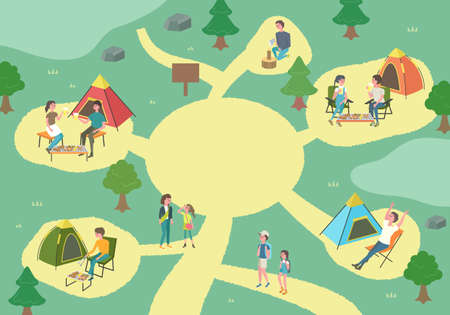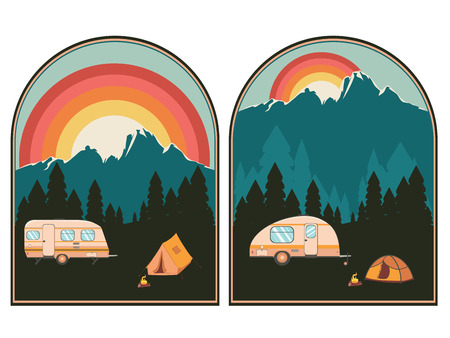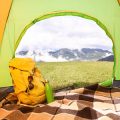1. Planning Your RV Adventure
Embarking on an RV trip through Americas national parks is an unforgettable experience, but a little planning goes a long way in making it smooth and enjoyable. From picking the right parks with RV hookups to knowing the best time to go, heres how to start your adventure on the right track.
Choosing National Parks with RV Hookups
Not all national parks offer full RV hookups (water, electricity, and sewer), so choosing parks that suit your rig’s needs is essential. Some parks have campgrounds with partial hookups or none at all. Heres a quick look at popular options:
| National Park | State | RV Hookups Available | Notes |
|---|---|---|---|
| Zion National Park | Utah | Partial (Electric only) | Watchman Campground has electric hookups |
| Grand Canyon National Park (South Rim) | Arizona | Full | Tusayan’s Trailer Village offers full hookups |
| Yellowstone National Park | Wyoming/Montana/Idaho | Limited | Fishing Bridge RV Park has full hookups (seasonal) |
| Everglades National Park | Florida | Partial (Electric only) | Flamingo Campground offers electric hookups for RVs |
Best Travel Seasons for National Parks
The best time to visit national parks varies by location. Here’s a general guide to help you decide when to hit the road:
| Region | Best Travel Months | Why? |
|---|---|---|
| Southwest (e.g., Zion, Grand Canyon) | March – May, September – November | Mild temps, fewer crowds, great hiking weather |
| Northern Rockies (e.g., Yellowstone, Glacier) | June – September | Parks fully open, ideal weather for outdoor activities |
| Southeast (e.g., Everglades) | November – April | Avoids hurricane season and extreme heat/humidity |
Essential Preparations Before You Go
Check RV Size Restrictions
Some campgrounds have length limits. Always check your RVs size against park restrictions to avoid surprises.
Reserve Early
Campsites with hookups fill up fast—especially in summer and holidays. Use Recreation.gov or NPS websites to book months in advance.
Create a Packing Checklist
A well-packed RV makes life easier on the road. Essentials include:
- Sewer hose and water pressure regulator for hookups
- Campsite leveling blocks and wheel chocks
- Navigational tools and physical maps (some parks have no signal)
- Sufficient food, water, and propane for remote areas
- Pest repellents and sunscreen for outdoor comfort
Know Park Rules and Fees
Each park has its own regulations. Familiarize yourself with quiet hours, fire restrictions, and entrance fees before arrival.
Your Adventure Starts With Smart Planning!
The more you plan ahead, the more youll enjoy the beauty of America’s national parks from the comfort of your RV. Now that you’ve got the basics down, youre one step closer to hitting the open road.
2. Top National Parks with RV Hookups
If youre planning an RV adventure and want to stay inside or near a national park, youll be happy to know that several U.S. national parks offer campgrounds with full or partial RV hookups. These include electricity, water, and sewer connections—everything you need for a comfortable and convenient stay. Heres a curated list of top national parks that cater to RV travelers.
Best National Parks with Full Hookups
| National Park | Campground Name | Hookup Type | State |
|---|---|---|---|
| Yellowstone National Park | Fishing Bridge RV Park | Full (Electric, Water, Sewer) | Wyoming |
| Zion National Park | Watchman Campground | Electric Only | Utah |
| Grand Canyon National Park (South Rim) | Trailer Village RV Park | Full (Electric, Water, Sewer) | Arizona |
| Everglades National Park | Flamingo Campground | Electric Only (Limited Sites) | Florida |
| Great Smoky Mountains National Park | Cades Cove Campground* | No Hookups (Dump Station Available) | Tennessee/North Carolina |
*While Cades Cove doesnt offer full hookups, its still popular among RVers for its scenic beauty and access to wildlife viewing.
Parks with Nearby Full-Service RV Campgrounds
Some national parks don’t have hookups directly within the park boundaries but offer nearby private or state-run campgrounds that do. Here are some examples:
| National Park | Nearby Campground | Amenities | Distance to Park Entrance |
|---|---|---|---|
| Yosemite National Park | Yosemite Lakes RV Resort | Full Hookups, Wi-Fi, Laundry | 5 miles |
| Rocky Mountain National Park | Moraine Park Campground* | No Hookups (Dump Station Available) | N/A (Inside the park) |
| Mesa Verde National Park | Morefield Campground | Full Hookups at Select Sites | N/A (Inside the park) |
This guide aims to help you pick the perfect spot for your next RV trip while enjoying the natural wonders of America’s national parks. In the next section, we’ll look into how to reserve your campsite and tips for booking during peak season.

3. What to Expect at RV Campgrounds
Planning an RV trip to a national park? Knowing what to expect at RV campgrounds can make your adventure smoother and more enjoyable. Each national park has its own setup, but there are common features and systems that most parks follow. Here’s a breakdown of what you’ll typically find when staying at RV-friendly campgrounds within U.S. national parks.
Reservation Systems
Most national parks use an online reservation system, often managed through Recreation.gov. Its highly recommended to book in advance—some spots fill up months ahead, especially during peak seasons like summer or holidays.
Reservation Tips:
- Book Early: Reservations can open up to 6 months in advance.
- Create an Account: Sign up on Recreation.gov for faster booking.
- Know Your Dates: Flexible dates increase your chances of finding available sites.
Campsite Sizes and Hookup Options
RV campsites come in various sizes and not all are created equal. Some parks only accommodate rigs under a certain length, while others offer full hookups for larger RVs. Heres a quick look at common campsite features:
| Campsite Feature | Description |
|---|---|
| Site Length | Ranges from 20 to 40+ feet; check site details before booking. |
| Electrical Hookups | Available at select campgrounds; may offer 30 or 50 amp service. |
| Sewer Hookups | A few parks offer sewer connections; dump stations are more common. |
| Water Hookups | A limited number of sites have direct water access; others rely on nearby spigots. |
| Paved Pads | Paved or gravel surfaces help with level parking and stability. |
Park-Specific Rules and Guidelines
No two national parks are exactly the same, so its important to understand each parks specific rules before arriving. These rules help preserve the natural environment and ensure safety for all visitors.
You Might Encounter Rules Like:
- No Generator Use After Hours: Quiet hours are usually enforced from 10 p.m. to 6 a.m.
- No Fires During Dry Season: Fire restrictions depend on weather conditions and time of year.
- Bears in the Area: Food storage regulations are strictly enforced in bear country.
- No Off-Road Parking: Always park your RV in designated areas only.
A Few Final Tips for Campground Comfort
- Packing Blocks or Levelers: Campsites aren’t always perfectly flat—bring tools to level your rig.
- Add an Extra Hose or Extension Cord: Sometimes hookups aren’t close by.
- Awnings & Shade: Not all sites have tree cover, so bring your own shade if needed.
The better you understand what each campground offers, the more enjoyable your stay will be. Check official park websites or Recreation.gov listings for detailed info on individual campgrounds before you go!
4. RV Camping Etiquette and Safety
Exploring national parks with your RV is an unforgettable experience, but its important to be a respectful and responsible camper. Whether youre parked at a full-hookup site or boondocking in a more primitive area, following basic etiquette and safety guidelines helps protect the environment and ensures everyone has a great time.
Campground Manners: Dos and Donts
Being considerate of fellow campers makes for a more enjoyable stay. Heres a quick overview of good RV camping behavior:
| Do | Dont |
|---|---|
| Arrive during daylight hours to avoid disturbing others | Run your generator late at night or early in the morning |
| Keep your site clean and organized | Let trash pile up or leave food out (attracts wildlife) |
| Respect quiet hours, usually from 10 PM to 6 AM | Play loud music or host noisy gatherings |
| Use designated paths and respect campsite boundaries | Cut through other campsites or trample vegetation |
| Leash your pets and clean up after them | Let pets roam freely or bark excessively |
Safety Tips for RVers in National Parks
Your safety—and that of others—should always come first. Here are some essential safety tips when staying in national parks:
- Know Your Rig: Make sure you’re familiar with your RV’s weight, height, and length before navigating narrow park roads or low-clearance tunnels.
- Check Weather Conditions: Some national parks have unpredictable weather. Monitor forecasts and be prepared for sudden changes.
- Secure Your Campsite: Use wheel chocks, stabilize your rig, and double-check hookups to avoid accidents or damage.
- Fire Safety: Only use fire rings where allowed, keep water nearby, and fully extinguish fires before leaving or going to bed.
- Wildlife Awareness: Never feed wild animals. Store food properly and keep a safe distance from all wildlife.
Environmental Responsibility
National parks are protected spaces. As RV campers, we have a duty to minimize our impact on these beautiful places.
Follow Leave No Trace Principles:
- Pack it in, pack it out: Take all trash with you, including food scraps and pet waste.
- Avoid dumping gray or black water improperly: Always use designated dump stations.
- Stay on marked roads and pads: This prevents damage to sensitive ecosystems.
- Limit light pollution: Use outdoor lights sparingly so others can enjoy the night sky.
Quick Tip:
If youre using solar panels or generators, be mindful of placement and noise—what works for you might disturb your neighbors.
By following these simple etiquette rules and safety precautions, youll not only have a smoother trip but also help preserve Americas treasured national parks for generations to come.
5. Exploring Beyond the Campsite
Staying at a national park with RV hookups gives you comfort and convenience, but the real adventure begins when you step outside your door. With your RV as your home base, there are endless ways to explore the natural beauty around you. Here are some fun and easy ideas to make the most of your trip.
Hiking Trails for All Levels
National parks offer hiking options for everyone—from casual strolls to challenging treks. Many trailheads are located near campgrounds or have parking nearby that can accommodate RVs. Be sure to check visitor centers or park maps for trail conditions and difficulty levels.
| Park | Popular Hike | Difficulty | Distance (round-trip) |
|---|---|---|---|
| Yosemite National Park | Mirror Lake Trail | Easy | 2 miles |
| Zion National Park | Emerald Pools Trail | Moderate | 3 miles |
| Grand Teton National Park | Taggart Lake Loop | Easy-Moderate | 3.8 miles |
Wildlife Viewing Tips
Many RV-friendly parks like Yellowstone and Everglades are known for their incredible wildlife. Early mornings and evenings are usually the best times to spot animals like elk, bison, or even bears. Bring binoculars, stay quiet, and always keep a safe distance—this is their home, after all!
Top Parks for Wildlife Watching
- Yellowstone: Bison, elk, wolves, bears
- Everglades: Alligators, manatees, birds
- Rocky Mountain: Moose, marmots, elk
Join a Ranger Program
Parks often offer free ranger-led programs that bring the landscape to life with stories, science, and hands-on activities. These might include guided hikes, evening talks at amphitheaters near campgrounds, or kid-friendly Junior Ranger programs. Check the schedule posted at campground bulletin boards or visitor centers.
Scenic Drives from Your RV Site
If hiking isn’t your thing—or you’re just looking for a relaxing day—take advantage of the scenic drives many parks offer. You can explore amazing viewpoints and photo spots without straying too far from your RV. Some even have designated RV pullouts so you don’t have to worry about space.
| Park | Scenic Drive Name | Mileage | Main Attractions Along the Way |
|---|---|---|---|
| Blue Ridge Parkway (NC & VA) | N/A (Entire Parkway) | 469 miles | Overlooks, waterfalls, wildflowers in spring/fall foliage in autumn |
| Zion National Park | Zion Canyon Scenic Drive | 6 miles (shuttle required seasonally) | Canyon views, Court of the Patriarchs, Big Bend viewpoint |
| Bryce Canyon National Park | Main Park Road | 18 miles one way | Bryce Amphitheater overlooks: Sunrise Point to Rainbow Point |
A Few Extra Tips for Exploring Safely & Comfortably:
- Stay hydrated: Always carry water with you—even on short hikes.
- Dress in layers: Weather can change quickly in the mountains or desert.
- Pace yourself: Especially if youre adjusting to higher elevations or new terrain.
Your RV gives you a solid home base—but adventure awaits just outside your door!


